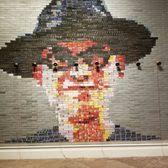
Is this the Culture or the Change?

This past weekend I revisited the Albright Knox Art Gallery, and walked through the “We the People” exhibit. The different pieces displayed there--the “artifacts” picked up from New York City streets, dented and rusted pots and pans collected from families, megaphones and logos, and broken mirrors --stood out to me. First was the initial thought that these pieces just seem influential. They were all individually impactful and could perhaps be referred to as “culture changers.” Second came the question:
Is this the culture or the change?

In all of these pieces, the art seemed to be more representative of current conditions than any prospective change. These reflections of current cultures allow us to more fully understand the objects, or at least see them, in a couple of different ways. The moment of reflection itself gives us time to consider the underlying issues in the ways in which we live and internally consider how we interact with these objects and issues in our own life. Additionally, these pieces offer piecemeal reflections of cultures broken down into their respective parts. This can help us to better see the impact that even seemingly smaller actions have in a larger cultural movement.

But why are the artists focused on the culture and not as much the change?
I’m not going to answer this question because there isn’t a “correct answer” here. This might not even be the question to ask because some “culture changers” are certainly focused on the change and not the culture. In regards to this question, I’ll offer two of my own thoughts in relation to the pieces I saw which I believe were more concentrated in the culture itself.
- Perhaps the artists find a cultural focus to be more efficacious in prompting change. When considering the future, proposed changes are often considered “outlandish” or “utopian” and in general are more easily critiqued because they are less concrete. However, when you confront someone with the actions in their own life that are detrimental to the people and environment around them, excuses are still an option but critiques are much more difficult to defend. It also prompts those who push for a better future in other ways to consider how they perpetuate the more detrimental aspects of the current culture in their own life and understand that change can not meaningfully occur unless we change those underlying issues.
- Individuals tend to be oddly drawn to self examination and reflection. These pieces that reflect the current culture satisfy this odd curiosity. Whether or not we want to think about these aspects of the culture, we tend to be drawn to that which relates to us. Images and projections of the future are more difficult to connect to self. Again, this may be a tactic to draw more attention to the need for change in terms of drawing in the audience.
These pieces all point out insufficiencies in the current culture and the naming of the exhibit (“We the People”) points to a collective effort. In this way, the exhibit is simply a method of communicating High Road principles.